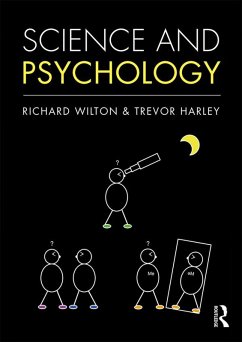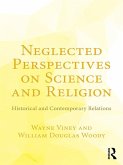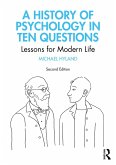

Alle Infos zum eBook verschenken

- Format: ePub
- Merkliste
- Auf die Merkliste
- Bewerten Bewerten
- Teilen
- Produkt teilen
- Produkterinnerung
- Produkterinnerung

Hier können Sie sich einloggen

Bitte loggen Sie sich zunächst in Ihr Kundenkonto ein oder registrieren Sie sich bei bücher.de, um das eBook-Abo tolino select nutzen zu können.
Science and Psychology provides a comprehensive introduction to the structure and characteristics of scientific explanation, using examples from a variety of sciences to illuminate the scientific approach taken in psychology. In addition, the authors discuss a range of conceptual issues particular to psychology. They examine the concepts of free will, consciousness, and purposeful behaviour, and consider the social implications of possible future changes in our understanding of these concepts and of ourselves. The final chapters of the book provide an account of what psychology can tell us…mehr
- Geräte: eReader
- mit Kopierschutz
- eBook Hilfe
- Größe: 1.69MB
![Neglected Perspectives on Science and Religion (eBook, ePUB) Neglected Perspectives on Science and Religion (eBook, ePUB)]() Wayne VineyNeglected Perspectives on Science and Religion (eBook, ePUB)52,95 €
Wayne VineyNeglected Perspectives on Science and Religion (eBook, ePUB)52,95 €![William James's Pluralism (eBook, ePUB) William James's Pluralism (eBook, ePUB)]() Wayne VineyWilliam James's Pluralism (eBook, ePUB)46,95 €
Wayne VineyWilliam James's Pluralism (eBook, ePUB)46,95 €![A History of Psychology in Ten Questions (eBook, ePUB) A History of Psychology in Ten Questions (eBook, ePUB)]() Michael HylandA History of Psychology in Ten Questions (eBook, ePUB)40,95 €
Michael HylandA History of Psychology in Ten Questions (eBook, ePUB)40,95 €![Systems Research for Behavioral Science (eBook, ePUB) Systems Research for Behavioral Science (eBook, ePUB)]() Systems Research for Behavioral Science (eBook, ePUB)51,95 €
Systems Research for Behavioral Science (eBook, ePUB)51,95 €![A Guided Science (eBook, ePUB) A Guided Science (eBook, ePUB)]() Jaan ValsinerA Guided Science (eBook, ePUB)46,95 €
Jaan ValsinerA Guided Science (eBook, ePUB)46,95 €![The Structure and Measurement of Intelligence (eBook, ePUB) The Structure and Measurement of Intelligence (eBook, ePUB)]() Hans EysenckThe Structure and Measurement of Intelligence (eBook, ePUB)48,95 €
Hans EysenckThe Structure and Measurement of Intelligence (eBook, ePUB)48,95 €![Advances in Environmental Psychology, Volume 6 (eBook, ePUB) Advances in Environmental Psychology, Volume 6 (eBook, ePUB)]() Advances in Environmental Psychology, Volume 6 (eBook, ePUB)32,95 €
Advances in Environmental Psychology, Volume 6 (eBook, ePUB)32,95 €-
-
-
Assuming no previous understanding of either the philosophy of science or any science other than psychology, Science and Psychology is an ideal resource for both final year undergraduates and postgraduates studying psychology. Psychologists and other scientists who wish to further their understanding of the relationship between psychology and the natural sciences may also find the contents to be of interest.
Dieser Download kann aus rechtlichen Gründen nur mit Rechnungsadresse in A, B, BG, CY, CZ, D, DK, EW, E, FIN, F, GR, HR, H, IRL, I, LT, L, LR, M, NL, PL, P, R, S, SLO, SK ausgeliefert werden.
- Produktdetails
- Verlag: Taylor & Francis eBooks
- Seitenzahl: 176
- Erscheinungstermin: 14. Juli 2017
- Englisch
- ISBN-13: 9781315529271
- Artikelnr.: 48786788
- Verlag: Taylor & Francis eBooks
- Seitenzahl: 176
- Erscheinungstermin: 14. Juli 2017
- Englisch
- ISBN-13: 9781315529271
- Artikelnr.: 48786788
- Herstellerkennzeichnung Die Herstellerinformationen sind derzeit nicht verfügbar.
Trevor Harley holds the Chair in Cognitive Psychology at the University of Dundee, and was previously Head of Department and Dean. He is now a science writer and journalist. He completed his undergraduate and postgraduate degrees at the University of Cambridge, and worked for many years on language, mental illness, and consciousness. He is author of several books, including The Psychology of Language, now in its fourth edition.
Explanation and its Application to Psychology Chapter 1: The defining
characteristic of science 1.1 Test your understanding of Chapter 1 Chapter
2: The structure of scientific explanation: The Standard View 2.1 The
Standard View 2.2 Observation statements 2.3 Statements that assert laws
2.4 Testing laws 2.5 Theoretical statements 2.6 Testing theories 2.7 More
on testing theories 2.8 Criteria used in deciding between theories 2.9 Test
your understanding of Chapter 2 Chapter 3: The structure of scientific
explanation: The Alternative View 3.1 The structure of scientific
explanation 3.2 General conclusion 3.3 Must we conclude that no observation
statement is incorrigible? 3.4 Conclusion 3.5 Implications for what one is
free to believe about the world 3.6 Criteria used to decide between
theories 3.7 Test your understanding of Chapter 3 Chapter 4: Some
historical examples of responses to a contradiction between a theory and
some apparent fact 4.1 Summary: the state of affairs at any one historical
time 4.2 Test your understanding of Chapter 4 Chapter 5: The criteria used
for choosing between competing theories 5.1 Axiomatic beliefs 5.2 Can
selection according to one's axiomatic beliefs be justified? 5.3 Power,
scope, simplicity 5.4 Historical evidence favouring simple theories 5.5 Can
a criterion of simplicity be justified? 5.6 Truth 5.7 Prediction 5.8
Explanatory content 5.9 Summary 5.10 Test your understanding of Chapter 5
Summary of Part 1: The characteristics of scientific explanation Part 2.
Understanding Behaviour Chapter 6: Typical approaches in psychology:
Internal mechanisms 6.1 The psychologist's goal 6.2 Internal operations
with no reference to embodiment 6.3 Granularity of explanation 6.4
Coarse-grained analysis 6.5 Fine-grained analysis 6.6 Connectionism 6.7
Some additional important points 6.8 Direct inspection of individual units
6.9 Test your understanding of Chapter 6 Chapter 7: Typical approaches in
psychology: Skinner's functional analysis 7.1 Objections 7.2 Test your
understanding of Chapter 7 Chapter 8: Common-sense psychology and its
implications 8.1 Common-sense explanations of human behaviour 8.2
Intentional states and causal explanations 8.3 Consequences of the two
accounts differing in kind 8.4 The relevance of Tolman's theory 8.5 The two
cases of sneezing, again 8.6 Verbal utterances 8.7 Some more examples 8.8
Some possible objections 8.9 Summary 8.10 Why do we like intentional
accounts? 8.11 Test your understanding of Chapter 8 Chapter 9: Free will
and determinism 9.1 Do laws of nature imply causality? 9.2 Laws of human
behaviour: Causality or free will? 9.3 Test your understanding of Chapter 9
Chapter 10: The possible impact on social institutions (the legal system)
if we relinquish our present disposition to believe in free will 10.1
Criteria for imposing punishment on offenders 10.2 Moral culpability 10.3
Deterrence 10.4 The possible impact of psychology upon the legal system
10.5 Comment on possible change in public attitude 10.6 Overall conclusion
10.7 Test your understanding of Chapter 10 Chapter 11: The problem of
consciousness 11.1 Consciousness 11.2 The characteristics of sensations
11.3 Direct apprehension 11.4 Not subject to error 11.5 The relationship
between sensations and physical events 11.6 Test your understanding of
Chapter 11 Summary of Part 2: Understanding behaviour Part 3: What
Psychology Tells Us About The Practice of Science Chapter 12: The use of
imagery in scientific thought 12.1 Characteristics of mental problem
solving 12.2 Are human disposed to use imagery in solving problems? 12.3
Examples of our disposition to use imagery 12.4 Conclusions so far 12.5 The
history of scientific thought 12.6 Test your understanding of Chapter 12
Chapter 13: Why are cultures that practise science better at controlling
the material world than non-scientific cultures? 13.1 (a) Structure of
scientific theories (b) The development of the written word (c) The
systematic testing of ideas (d) Different a priori assumptions about the
world (e) Acceptance of fundamental change 13.2 Conclusion 3.3 Test your
understanding of Chapter 13 Summary of Part 3: Psychological constraints on
scientific explanations References
Explanation and its Application to Psychology Chapter 1: The defining
characteristic of science 1.1 Test your understanding of Chapter 1 Chapter
2: The structure of scientific explanation: The Standard View 2.1 The
Standard View 2.2 Observation statements 2.3 Statements that assert laws
2.4 Testing laws 2.5 Theoretical statements 2.6 Testing theories 2.7 More
on testing theories 2.8 Criteria used in deciding between theories 2.9 Test
your understanding of Chapter 2 Chapter 3: The structure of scientific
explanation: The Alternative View 3.1 The structure of scientific
explanation 3.2 General conclusion 3.3 Must we conclude that no observation
statement is incorrigible? 3.4 Conclusion 3.5 Implications for what one is
free to believe about the world 3.6 Criteria used to decide between
theories 3.7 Test your understanding of Chapter 3 Chapter 4: Some
historical examples of responses to a contradiction between a theory and
some apparent fact 4.1 Summary: the state of affairs at any one historical
time 4.2 Test your understanding of Chapter 4 Chapter 5: The criteria used
for choosing between competing theories 5.1 Axiomatic beliefs 5.2 Can
selection according to one's axiomatic beliefs be justified? 5.3 Power,
scope, simplicity 5.4 Historical evidence favouring simple theories 5.5 Can
a criterion of simplicity be justified? 5.6 Truth 5.7 Prediction 5.8
Explanatory content 5.9 Summary 5.10 Test your understanding of Chapter 5
Summary of Part 1: The characteristics of scientific explanation Part 2.
Understanding Behaviour Chapter 6: Typical approaches in psychology:
Internal mechanisms 6.1 The psychologist's goal 6.2 Internal operations
with no reference to embodiment 6.3 Granularity of explanation 6.4
Coarse-grained analysis 6.5 Fine-grained analysis 6.6 Connectionism 6.7
Some additional important points 6.8 Direct inspection of individual units
6.9 Test your understanding of Chapter 6 Chapter 7: Typical approaches in
psychology: Skinner's functional analysis 7.1 Objections 7.2 Test your
understanding of Chapter 7 Chapter 8: Common-sense psychology and its
implications 8.1 Common-sense explanations of human behaviour 8.2
Intentional states and causal explanations 8.3 Consequences of the two
accounts differing in kind 8.4 The relevance of Tolman's theory 8.5 The two
cases of sneezing, again 8.6 Verbal utterances 8.7 Some more examples 8.8
Some possible objections 8.9 Summary 8.10 Why do we like intentional
accounts? 8.11 Test your understanding of Chapter 8 Chapter 9: Free will
and determinism 9.1 Do laws of nature imply causality? 9.2 Laws of human
behaviour: Causality or free will? 9.3 Test your understanding of Chapter 9
Chapter 10: The possible impact on social institutions (the legal system)
if we relinquish our present disposition to believe in free will 10.1
Criteria for imposing punishment on offenders 10.2 Moral culpability 10.3
Deterrence 10.4 The possible impact of psychology upon the legal system
10.5 Comment on possible change in public attitude 10.6 Overall conclusion
10.7 Test your understanding of Chapter 10 Chapter 11: The problem of
consciousness 11.1 Consciousness 11.2 The characteristics of sensations
11.3 Direct apprehension 11.4 Not subject to error 11.5 The relationship
between sensations and physical events 11.6 Test your understanding of
Chapter 11 Summary of Part 2: Understanding behaviour Part 3: What
Psychology Tells Us About The Practice of Science Chapter 12: The use of
imagery in scientific thought 12.1 Characteristics of mental problem
solving 12.2 Are human disposed to use imagery in solving problems? 12.3
Examples of our disposition to use imagery 12.4 Conclusions so far 12.5 The
history of scientific thought 12.6 Test your understanding of Chapter 12
Chapter 13: Why are cultures that practise science better at controlling
the material world than non-scientific cultures? 13.1 (a) Structure of
scientific theories (b) The development of the written word (c) The
systematic testing of ideas (d) Different a priori assumptions about the
world (e) Acceptance of fundamental change 13.2 Conclusion 3.3 Test your
understanding of Chapter 13 Summary of Part 3: Psychological constraints on
scientific explanations References







